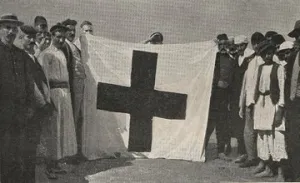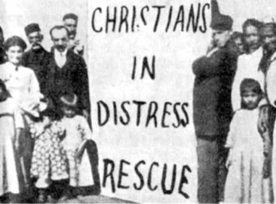Surviving Against All Odds Through Resistance and Resilience
- khachatryandavit19
- Apr 16, 2023
- 8 min read
Updated: Apr 17, 2023
In his seminal work, “De Jure Naturae Et Gentium” Samuel Pufendorf defines self-defense as “the warding off of evils which tend to a man’s injury and are the threatened by another man.” And Cicero in his foundational text on the topic, “Oration for Titus Annius Milo” describes self-defense as a means of countering violence with violence.
The late 19th and early 20th centuries were particularly dark periods for the Armenian people in the Ottoman Empire. A wave of unprecedented persecution and violence led to the annihilation of about two million Armenians in total, with the atrocities culminating in what is now widely recognized as one of the most tragic events in modern history: the Armenian Genocide.
Amid this unimaginable tragedy, there were also stories of hope, resilience, and resistance. In various cities and villages throughout Western Armenia and Cilicia and the rest of the Ottoman Empire, Armenians took up arms and fought back against their resist Turkish and Kurdish murderers, sometimes for weeks and months. These heroic self-defense actions not only saved many lives but also became a symbol of defiance and dignity for the Armenian people. This blog post will explore some of the most notable examples of Armenian self-defense during the genocide, highlighting their strategies, sacrifices, and legacy.
Van
The Armenian community of Van was the first to take up arms and organize a powerful self-defense campaign in 1915. In Van and the surrounding regions Armenian men, women, and children fiercely resisted the hordes of Turkish and Kurdish murderers. During April and May of 1915, intense clashes ensued in the provinces of Shatakh and Moks, where the local Armenian population fought until receiving assistance from Armenian volunteers. The city of Van, home to approximately 22,500 Armenians, witnessed the development of a robust self-defense organization amidst the turmoil.

According to witness accounts, as the defenders were running low on ammunition, they came up with an ingenious solution: they gathered whatever gold they had, including precious crosses, and melted it down to make bullets in order to continue their resistance against the Turks.
Ironically a few oppressors had the honor of being brought down by bullets made of gold, while many others were hit by copper bullets only that were molded from kitchen utensils. C’est la vie, asker and killing innocent people is no easy business either. It’s not always rainbows and butterflies, I mean exhausted, starved-to-death women and children.
The Armenian community of Van was mainly located in two districts - Aygestan and Old Town. The situation became even more alarming when tens of thousands of Armenians from the surrounding province sought refuge in Van to escape the massacre. With no other option left, the Van residents had to resort to an armed struggle.
Armenians hastily established a military headquarters in Aygestan with Armenak Yekaryan as the leader, along with Aram Manukyan and other members. Haykak Kosoyan commanded armed forces in the Old Town area. The self-defense of Van began on April 7th and lasted for approximately a month. Women, girls, and even youths participated in the fighting, believing that it was better to die than surrender. The news of the Russian army's advance and the arrival of Armenian volunteers resulted in the Turks retreating. On May 5th, the first Armenian volunteers entered Van.
On May 7, Aram Manukyan was appointed as the governor of Van, marking a significant moment in the historyof the Armenian self-defense movement and, disaster response and management through swift political measures. However, due to the retreat of the Russian army in July, the Armenian authorities in Van ceased functioning, leaving the Armenians vulnerable to Turkish attacks. The Turks dutifully entered the city and massacred the exhausted and disarmed Armenians. The Russian army recaptured Van the next month, but by that time the city was already devoid of Armenians. You do the math…

Déjà vu: Flashback or muzzle flash?
This wasn’t the first time Armenians were forced to take up arms to face the imminent existential threat. Perhaps little did they know that wouldn’t be the last time either. Nonetheless, I think they oughtn’t to have known; it is one’s unalienable life to defend oneself. You don’t need an agenda or incitement to be armed, because it is the least you can do to fully exercise the right of self-defense when the bells go off again. And the bells will go off. They always do.
In May of 1895, European powers pressured Sultan Abdul Hamid II to agree to new reforms that would reduce the powers of the Hamidiye Cavalry, but these reforms were not put into effect, much like the Treaty of Berlin. The Red Sultan believed that the solution to the “Armenian question” was the eradication of the Armenian people. In October of the same year, 2,000 Armenians gathered in Istanbul to demand the implementation of the reforms, but Ottoman police units violently dispersed the gathering. Afterward, massacres broke out against Armenians in Istanbul itself and spread to other regions, particularly in districts with significant Armenian populations such as Badlis, Diyarbakir, Erzurum, Harrods, Sivas, Trabzon, and Van.
In 1896, Turkish troops entered Van on June 3rd, supported by Hamidian troops. The Armenian residents fiercely resisted the attack, but Turkish regular troops bombarded the city's districts with German cannons, leading to a destructive fire. The situation for the defenders worsened as a continuous flow of Armenian villagers from surrounding areas sought refuge in the city.
The European consuls intervened to help reconcile the conflict, and the Armenians accepted the terms of the agreement proposed through their mediation. As part of the agreement, the Turkish authorities promised to allow the defenders to cross into Persia without any obstacles. However, the Turks did not keep their promise. When 1500 people from Van arrived at the Persian border, they were attacked by Kurdish bandits and only 30 people survived. Mkrtich Avetisyan was among those who died. The Turks killed approximately 20,000 people in Van and its surroundings, destroyed several monasteries in Vaspurakan, and destroyed numerous manuscripts.
In the 1890s, the Ottoman Empire saw the destruction of around 300,000 Armenians in a series of massacres that are collectively referred to as genocide. Despite reforms signed by Abdul Hamid II, they were not implemented and violence against Armenians continued to spread throughout the regions they inhabited, including Istanbul and other cities.
Shapin Karahisar
The Armenian quarter of Shapin Karahisar city was the site of a fierce resistance that began on June 3. Ghukas Teovletyan led a military council to manage the local self-defense. Over 5,000 Armenians took shelter in the ancient fortress near the city, where they bravely repelled all enemy attacks. However, by the end of June, the lack of food, water, and medicine made the situation utterly dangerous. The military council decided to break through the enemy's siege before starvation weakened the people. Late on June 29, around 1,000 Armenian men attacked the Turkish forces and successfully broke through the siege. Sadly, the remaining Armenians who were still in the fortress were slaughtered by the Turks who stormed it.
The Forty Days of Musa Dagh
The battle of Musa Dagh serves as a remarkable example of the unwavering determination and selfless struggle of the Armenian people. In the summer of 1915, Turkish authorities demanded the deportation of the Armenian population in Suetia province. However, more than 4,200 residents of six Armenian villages decided to resist and seek refuge on nearby Musa Mountain.
They built temporary fortifications to defend themselves and put up fierce resistance against the Turkish army. When their supplies of food and ammunition dwindled, they resorted to creative measures to attract the attention of allied warships patrolling the Mediterranean coast. They raised two flags made from bed sheets, one bearing a red cross and the other with the message "Christians are in danger." They also lit bonfires around the flags to make them more visible from the sea.
Armenians formed an administrative body for defense, with Tigran Andreasyan as the president and Yesai Yaghubyan as the head of the military unit. The Outnumbered and outgunned, Armenians valiantly threw back the numerous attempts by the 20000-strong Turkish forces to dislodge them. Armenians persisted in their resistance, even after their food stores dwindled after a month-long siege. The only hope was to be rescued by an Allied ship patrolling the Mediterranean coast. Their efforts ultimately paid off when a passing French warship spotted the flags and came to their rescue. Eventually, five Allied ships, Le Guichen, L'Amiral Charner, Le Desaix, La Foudre, and Le D'Estrées, approached the shore, cast anchor, and dropped boats.

The story of the Musa Dagh resistance inspired Franz Werfel, a Prague-born Austrian writer, to pen a novelized version of the events called The Forty Days of Musa Dagh. Published in 1933, the book quickly became a bestseller, but with Hitler՛s rise to power, Werfel, who was Jewish, fled Vienna that same year. Despite this setback, The Forty Days of Musa Dagh was eventually translated into eighteen languages, and plans were announced for a Hollywood movie adaptation by Metro-Goldwyn-Mayer. However, the Turkish ambassador's objections to the Department of State led to the United States government's involvement, and MGM Studios eventually canceled the project.
In Eastern Europe, many Jews saw Werfel's novel as a warning about their fate. During the Holocaust, copies of the book were reportedly circulated as a source of inspiration and a call to arms among Jews confined to ghettos by the Nazis.
Urfa
Urfa (Edessa) was home to 35,000 Armenians out of a total population of 100,000. The Young Turks, who were in power at the time, had long been planning to eliminate the Armenian population. They attempted to do so by catching them off guard, but the Armenians were prepared. When the bells of the Armenian church rang out, Armenians were called to arms.







Comments